
views
Bringing Your Cat Home
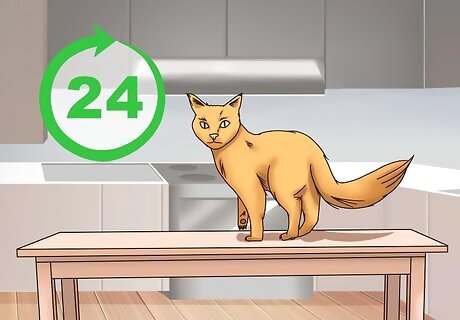
Give your new pet some space when you first bring them home. Give your cat a day to explore. This way, the cat can get used to its new home and new surroundings.

Approach the cat slowly and carefully. Walk up to your cat gently. Watch your cat's body language for signs of fear, nervousness or interest and curiosity. Each cat will react differently, and will show signs when it is growing comfortable. If your cat is flattening its ear or flicking its tail back and forth quickly, those are red flags that it's not very comfortable.

Pet your cat. Start with stroking your cat under the chin. Move on to belly rubs and scratching under the chin.
Making Friends With a Cat

Bond early, if possible. Cats become socialized between two and nine weeks of age. If you adopt or befriend a cat during this time frame, it is easier to develop a relationship. Make interaction positive. Cuddle, praise and play with the cat as much as it wants. Unless it compromises safety or wellness, avoid any and all situations that could create pain or negativity for the cat. Demonstrate to the cat that you are trustworthy and loving. Cats learn best through positive reinforcement rather than punishment. Give your cat treats and praise when it does something good to reinforce the behavior.

Let the cat approach you. Cats are notoriously independent and aloof when they choose to be. Don’t view this as a sign that the cat dislikes you. If a cat chooses to be in the room with you, this means they are curious about you, even if they do not immediately approach. Avoid staring. Sustained eye contact is construed as a threat to many animal species. When looking at a cat, if it looks back at you, look back, slowly blink your eyes a few times, then look away. By doing this, you are indicating you are non-threatening to the cat. Try sitting or laying on the floor. Humans are very tall when compared to cats. As a result, it can seem intimidating to them when standing or sitting on furniture and reach down toward them. To make yourself more approachable, consider sitting or laying in the floor while petting or playing. This can make the cat more comfortable.
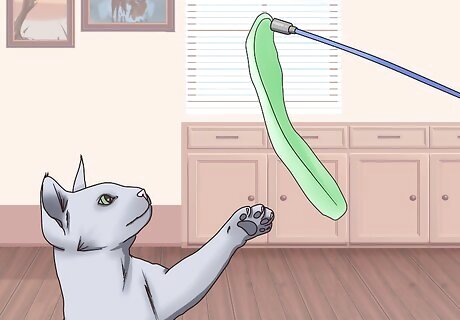
Play with the cat. One way to interact with a shy, but curious cat, is to engage it in play. Try a wand. Wands are great to use with a new feline friends because they provide distance between you and the cat while facilitating interaction. If a wand toy isn’t available, try a string or make your own with a piece of string or twine tied to a long stick. Avoid rough housing. Humans are strong and large from the perspective of a cat, which can trigger its instincts as a prey animal. When roughhousing with a cat, you can run the risk of frightening it or teaching it aggressive tendencies. When playing with a cat, never grab, throw, pinch, or offer any other behavior that could be construed as threatening. Additionally, don’t tickle the belly, as this can trigger an attack response in even the calmest, sweetest kitty. Cats especially love playing with small, fast-moving toys.

Offer treats. Archaeologists tell us that the first domesticated cats became so because humans offered gifts of food or scraps. This act encouraged cats to live with them. The same offerings of food and treats can help cement cat bonding, even with modern domesticated felines. Don’t give people food. Feeding cats people food can lead to negative behaviors like begging, food stealing, or scavenging kitchen scraps when your back is turned. As well, some human foods will upset a cat’s digestion and lead to food poisoning. Always feed foods and treats that are designed for consumption by cats.
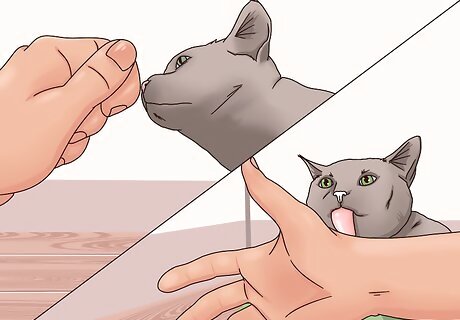
Be sniffed or licked. Animals have unique glands in the roof of their mouth that helps them both smell and identify people and other animals. The sensory areas in their nose track a different set of smell data. This means that, sometimes, a cat will both lick and sniff you, to become acquainted. The licking can also be an allogrooming behavior of affection. Allogrooming is a behavior typically performed between animals of the same species. This represents an acceptance of you into your cat's family. Don’t grab. Sniffing for a cat is an introduction. For example, when interacting with other people, it would be considered rude if someone asked for your name and you grabbed them in a hug. Don’t grab or hug a cat when it shows interest in your by sniffing. Don’t move suddenly. Cats can be prey in the wild and have instincts to flee when a nearby larger animal moves suddenly. Avoid triggering this panic response, as it can make the cat skittish and jumpy when around people.

Don’t pet until invited. Just because a cat is near you doesn’t mean that it is asking for you to pet it. Pay attention to the body and vocal language of the cat to note when petting and affection has been given the green-light. Recognize encouraging behavior. Cats are demonstratively affectionate when they want food or petting. Below are some of the characteristics to look for: Bunting: Bunting is when the cat nuzzles our hands or legs when it wants our attention. Cats have scent glands in their chin and the top of their head that they rub against people they like and want to claim. Rubbing. Cats that want pets will often rub up against our legs or curl their tail around them, actually petting humans with their body. Lap sitting. When a cat wants human companionship, they will often invite themselves to sit next to us or in our lap. Stretching. Some cats engage in standing stretching, or stretching while laying on the ground as a show of relaxation and an encouragement to humans to give pets. Just remember that, even if it is showing, the belly is not a good place to start. Chirping or barking. Cats do not vocalize with other cats frequently. They are, however, known to have complex vocal relationships to human caregivers. The cat is not actually using direct, lingual communication; however, it does learn how to use the right vocal tones and pitches to communicate its needs and attitudes toward humans.

Give the cat a safe space. At all times, when making friends with a cat, be sure the cat has access to a safe space. A safe place is where it can go if it feels tired, overwhelmed or frightened. Don't pull or remove the cat from its safe space. When it goes there, it is telling you that it is overwhelmed and needs a break. Removing a cat from its safe space while it is frightened may mean that the cat will no longer believe it has a safe space, creating anxiety and possible acting-out behaviors like scratching or marking. Don't corner or block the cat. Let the cat move freely throughout the house, even if you aren't entirely ready to be done interacting. Remember that letting the cat go now means it will return later so visit with you, instead of being afraid of you and refusing your friendship.
Making Friends With an Adopted or Stray Cat

Know the difference between “stray” and “feral.” “Stray” refers to a lost or abandoned animal that has been socialized by or with humans. “Feral” refers to cats that were socialized without human contact. Pay attention to the cat’s condition and appearance. Disheveled or dirty looking cats are typically strays that have been abandoned and never learned how to clean properly outside of a home environment. Do not approach feral cats directly. Feral cats were born out of doors and grew up apart from human socialization. In fact, they usually show no interest in human socialization, are fundamentally wild, and should be treated with the same caution exercised toward animals like foxes or raccoons, known to carry diseases like rabies.

Put out food. Stray and feral cats are scavengers. For this reason, they are likely to accept offerings of kibble or wet cat food if offered. Put the food out when you see them. If the cat comes around, take the food out then. Using a soft voice to talk to the cat, set the food down in a safe, open area. Give them space. After setting the food down, retreat at least 20 yards, possible more, so that the cat feels non-threatened. If the cat is interested in the food, you may see a kind of nodding movement, where the cat is sampling the smell of the food from the air. If the cat approaches, continue talking to the cat in reassuring tones. Talk while it eats and watch its body language. Does the tail move gently and restfully or does it lay flat? Do the ears swivel or remain folded back against the head? If the body language shows in restful tail movements and the swiveling ears, the cat is paying attention to you, likely stray, and can be approached gradually over time. Build a routine. If you put food out at around the same time each day, the cat will start to expect this behavior and even wait for you to put out the food. After several days, you can begin moving closer while the cat eats. Try decreasing distance by a couple of feet every feeding. If you reach a point where the cat seems evasive or unwilling to eat, slowly back up a few feet until it returns to the food.
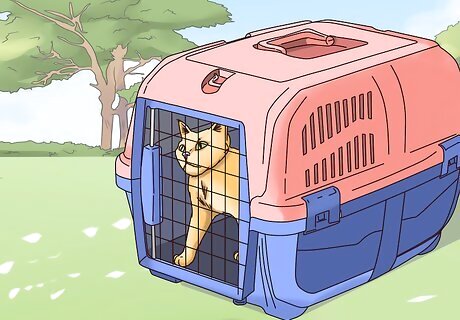
Cage your cat, if necessary. It is important to make sure outdoor cats are spayed or neutered to prevent any increase to the homeless pet population. Caging is often required to bring these cats into captivity to surgery. This is also a way of capturing a stray cat for adoption or medical attention. Cages can be rented for a returnable deposit from the humane society or SPCA. Simply add food to the back of the cage and set in an area you know stray or feral cats frequent. Check back every 4 hours or the morning after setting the trap to see if a cat has been trapped. Unless very sick, a feral cat will become extremely aggressive when caged and will require special handling, like gloves and a blanket to cover the cage.

Be patient. Stray cats are often that way because they were abused or abandoned by a prior owner. This means they are very likely to be afraid of humans. Bringing a stray back around to human interaction can be a long process, depending on factors like age, the amount of time within a human home, and the nature of mistreatment it experienced. Strays often become devoted to their caregivers but, because of their abandonment or mistreatment, never really come around to other humans who visit the home. It’s a good rule of thumb to prepare visitors for how to interact with the cat to avoid stress or misunderstanding for either party.
Understanding Cats
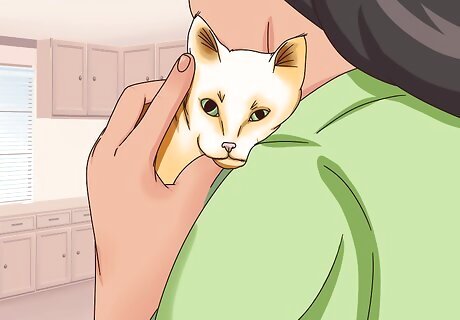
Understand that cats experience love. Although their aloofness has bred a reputation for apathy and a lack of love, cats actually have the same chemical responses in their brain when they have positive interactions with people and other friendly animals and can build close bonds and attachments to humans and other cats. The love response is created by oxytocin, a chemical secreted by the brain when we experience strong attachment.

Listen to your cat. Cats are intelligent enough to master vocalization with their human companion, provided humans pay attention. What sounds does you cat make in response to various activities like feeding? Cuddling on the couch? Play time? When it wants to get in your lap? Note trends in vocalization to better understand what your cat is attempting to tell you. Purring means different things. Science hasn’t completely nailed down why cats purr. We know mother cats do it when nursing. We also know that cats purr when they are happy. But cats also purr when they are attempting to calm themselves down, even when giving birth. When your cat purrs, take notice of the context and that can help explain the purpose of that specific purr.

Pay attention to body language. Tail up means “Hi! I’m feeling friendly.” Tail down means “I’m hunting, or not interested in interacting with you at the moment.” Staring means “I don’t know what to think about you, and I might be a little concerned.” Long, slow blinking means “I am comfortable around you. You are my friend.” Laying down on her side and stretching means “I’m relaxed and would like petting.” Laying down with ears back and a rigid posture means “I’m really frightened and will kick, scratch, or bite if you come closer.” There are some responses among cats that are universal; and yet, there are others that are specific to each feline. Some cats puff up slightly when they are feeling cuddly or excited about affection (this is normally a reaction associated with aggression and fear). Some cats will grab you lightly with their claws when they want to get your attention to be picked up, petted or fed (this can also be a sign of unhappiness or aggression). Be sure to pay attention to your specific cat and learn the nuances of his or her behavior.
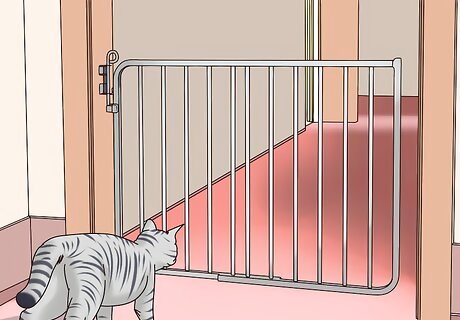
Accept the cat will be curious. Cats consider a closed door to be a personal challenge. They will attempt to sneak in to sate curiosity. The same thing can be true of closed cabinets, drawers, closets, and other storage areas. If the area is off limits because it is dangerous to the cat, install child locks or doorknobs that the cat cannot tug to open. If the area is not dangerous but they don’t need to be there without supervision, try to give the cat regular, supervised time in the space to explore and demystify it. This will sate their curiosity and prevent them from darting in each time you open the door. Think about your cats when you make life choices. Cats get bored and need stimulation that satisfies their natural instincts. Where you live, furniture you bring into the home, and the amount of window space can place a significant role in creating a cat-friendly environment. Below are some considerations to keep in mind: Are you living in a place where a cat can reasonably sit in or look through a window? Cats will look for ways to get to windows where they can look outside, even to the detriment of drapes and objects of furniture required to vault to these spaces. Try to provide window seating for your cat, using either a window shelf or putting a piece of furniture under a window that the cats can rest on. Can you arrange furniture and shelving to let your cats perch above a room? Cats in the wild climb trees when they want to nap safely or feel threatened. Put a tall scratching and play tower near a bookcase or window. If near a window, put shelving over the window that is reachable from the top tier of the cat tower. Now when the cat feels insecure or wants an out of the way place to nap, they can climb up to a high spot in the room and feel more confident.

Accept that your cats will climb on everything. Cats are active, particularly at night, and will climb, run, and play throughout the house. Is the couch you want in the kind of material that will do well with cats? Thin, easily scratched materials like microsuede or woven, easily picked materials like brocade can be quickly destroyed by active felines. Choose something like a duck canvas or velour, or get a couch cover for day-to-day use. Do you have scratching posts? Cats have scent glands in their feet and are predisposed to scratching in high-traffic areas to remind other animals and people that they have a stake in this room. If you notice the cat scratching something it shouldn’t, put a scratching post in that area or consider rearranging the room so that the scratching post is located in a high-traffic area near a busy doorway. You can also put double-sided tape on the edges of furniture, etc. to prevent cats from scratching.



















Comments
0 comment